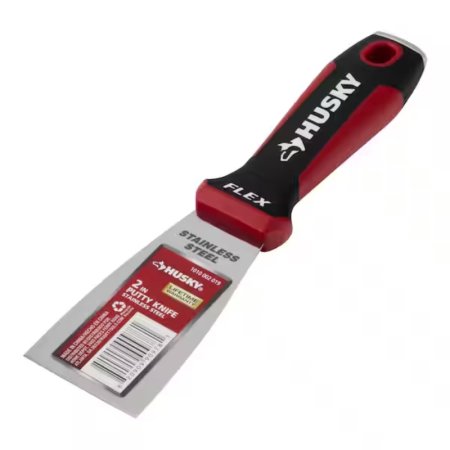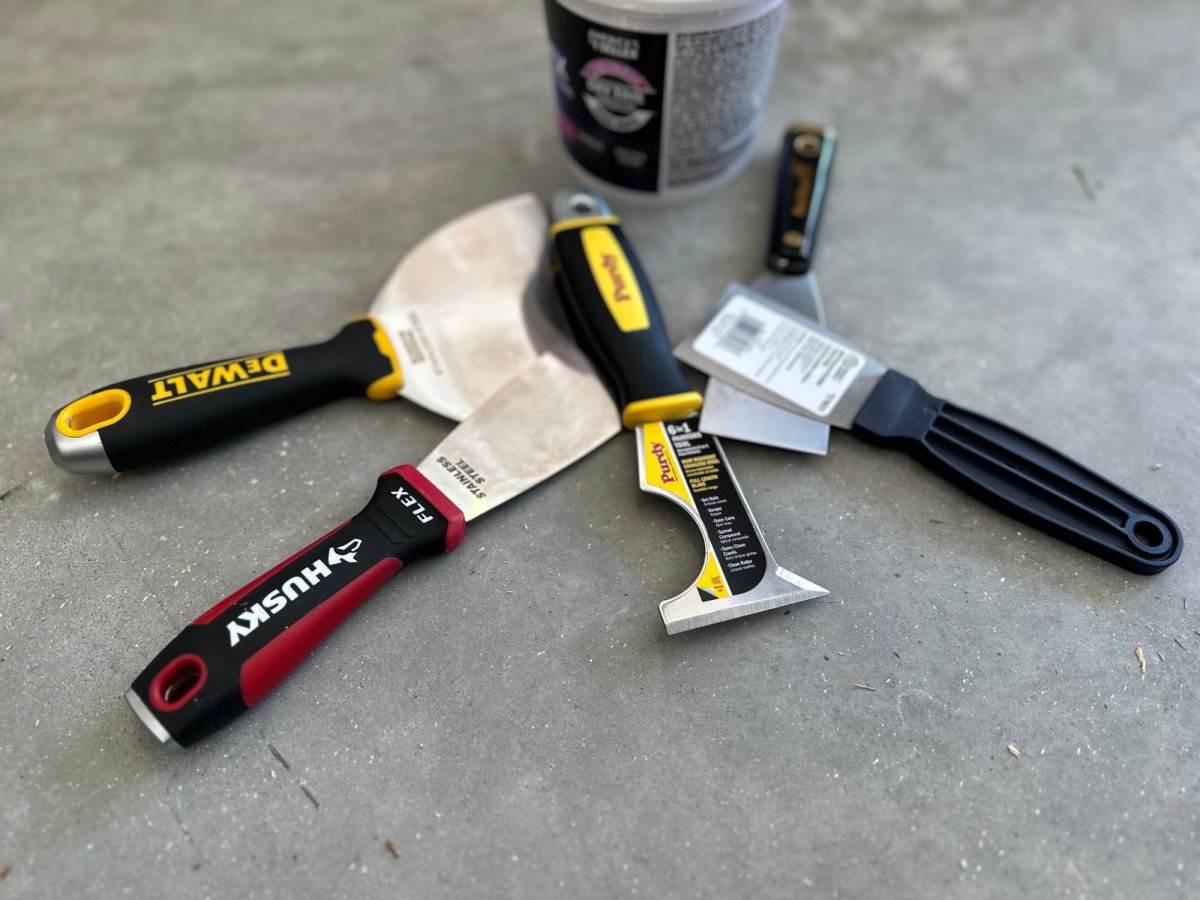
We may earn revenue from the products available on this page and participate in affiliate programs. Learn More ›
Whether you’re patching nail holes before painting a new wall, mudding over drywall joints, or scraping away old paint or wallpaper, putty knives are crucial to the job. These simple yet essential tools consist of a handle with a thin metal blade that’s flexible enough to feather joint compound to a smooth finish while still being rigid enough to separate old paint or wallpaper from a wall.
While these tools are simple, there are important features to consider when shopping for the optimal putty knife, including blade size and handle design. I tested five of the top putty knives and found the Husky 2-Inch Putty Knife With Stainless Steel Blade, with its durable stainless steel blade and comfortable handle, to be the best of the bunch.
Keep reading to find out more about this top pick and learn how to choose the correct type and size of putty knife for a given job. Whether you’re taping and mudding drywall, scraping away stubborn wallpaper, or spackling nail holes to prep for a new coat of paint, you’re sure to find the best putty knife for your needs.
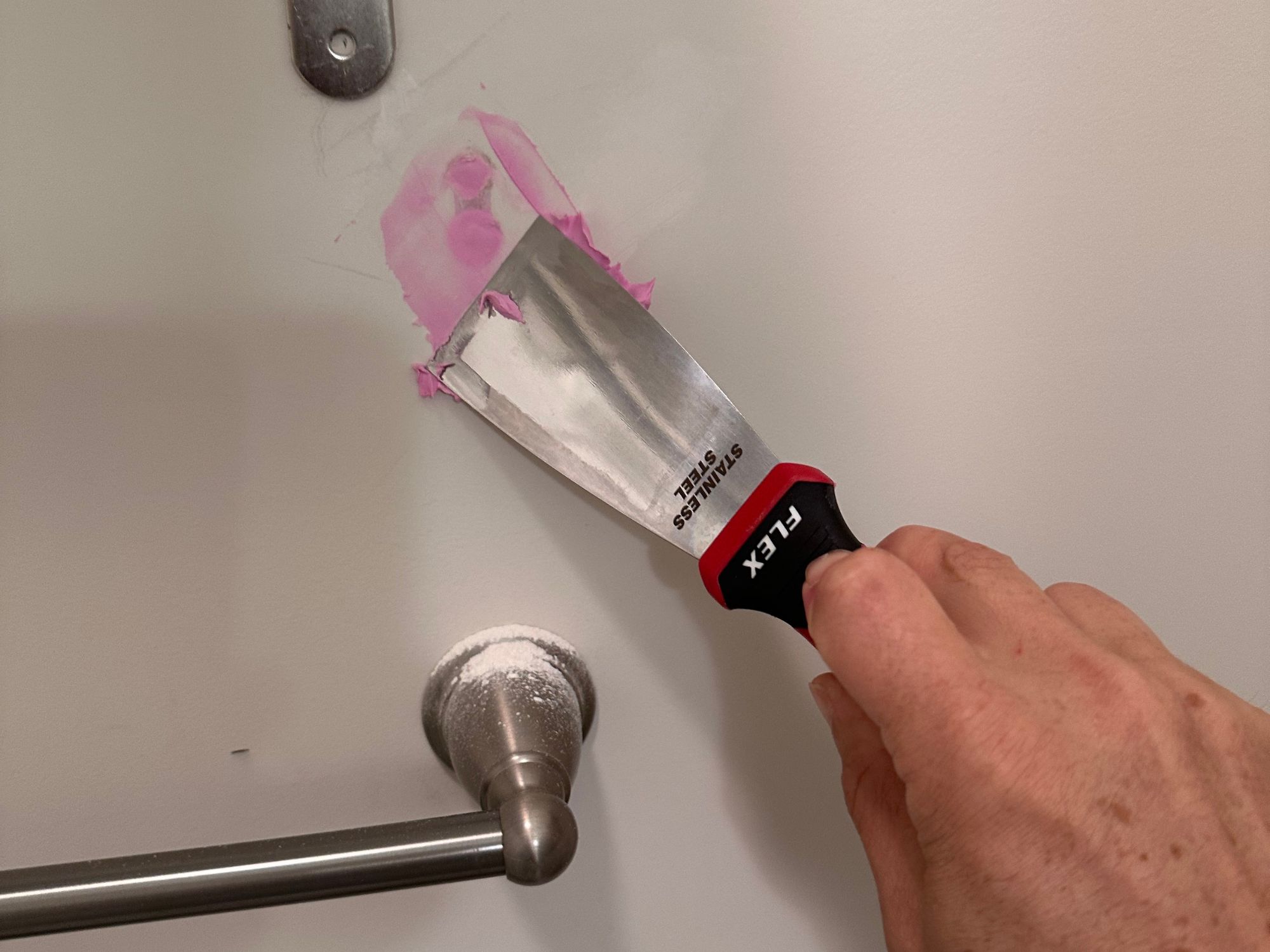
| Testing Stats | |
| Products tested | 5 |
| Time spent testing | 3 hours |
| Tests performed | 2 |
| Price range | $5 to $20 |
Best Overall
Husky 2-Inch Putty Knife With Stainless Steel Blade
What We Like
- Comfortable ergonomic handle with rubber grip
- High-quality stainless steel blade
- Lightweight and balanced feel
What We Didn’t Like
- Blade could lack the flexibility for some tasks
Product Specs
- Blade width: 2 inches
- Blade length: 3.5 inches
- Material: Stainless steel
Our Ratings: Ergonomics 5/5; Performance 4.5/5; Durability 5/5; Value 5/5
Husky separates itself from the pack with the quality of the handle on this small putty knife. It’s beefier than most other putty knife handles and features a secure rubberized grip. Whereas other putty knives I tested felt too small for my hand, this Husky putty knife conformed perfectly to it. During my testing, I had a feeling of greater control and leverage when bearing down to scrape old paint. This putty knife also had a stiffer blade than other putty knives I tested, making it especially effective as a scraper.
In terms of build quality, the combination of a beefy handle and thicker blade gives this knife a durable feel. It powered through my paint scraping test without any noticeable wear or tear. In short, this Husky model is a putty knife that should last for many projects. While the blade does lack the flexibility of other putty knives I tested, it wasn’t so stiff that it was difficult to apply a smooth layer of spackle over nail holes and divots in drywall.
Overall, the Husky putty knife felt like a higher-quality product compared to similarly priced knives I tested, making it a great value and truly a no-brainer when it comes to choosing a putty knife.
Get the Husky putty knife at The Home Depot.
More Putty Knives Worth Your Money
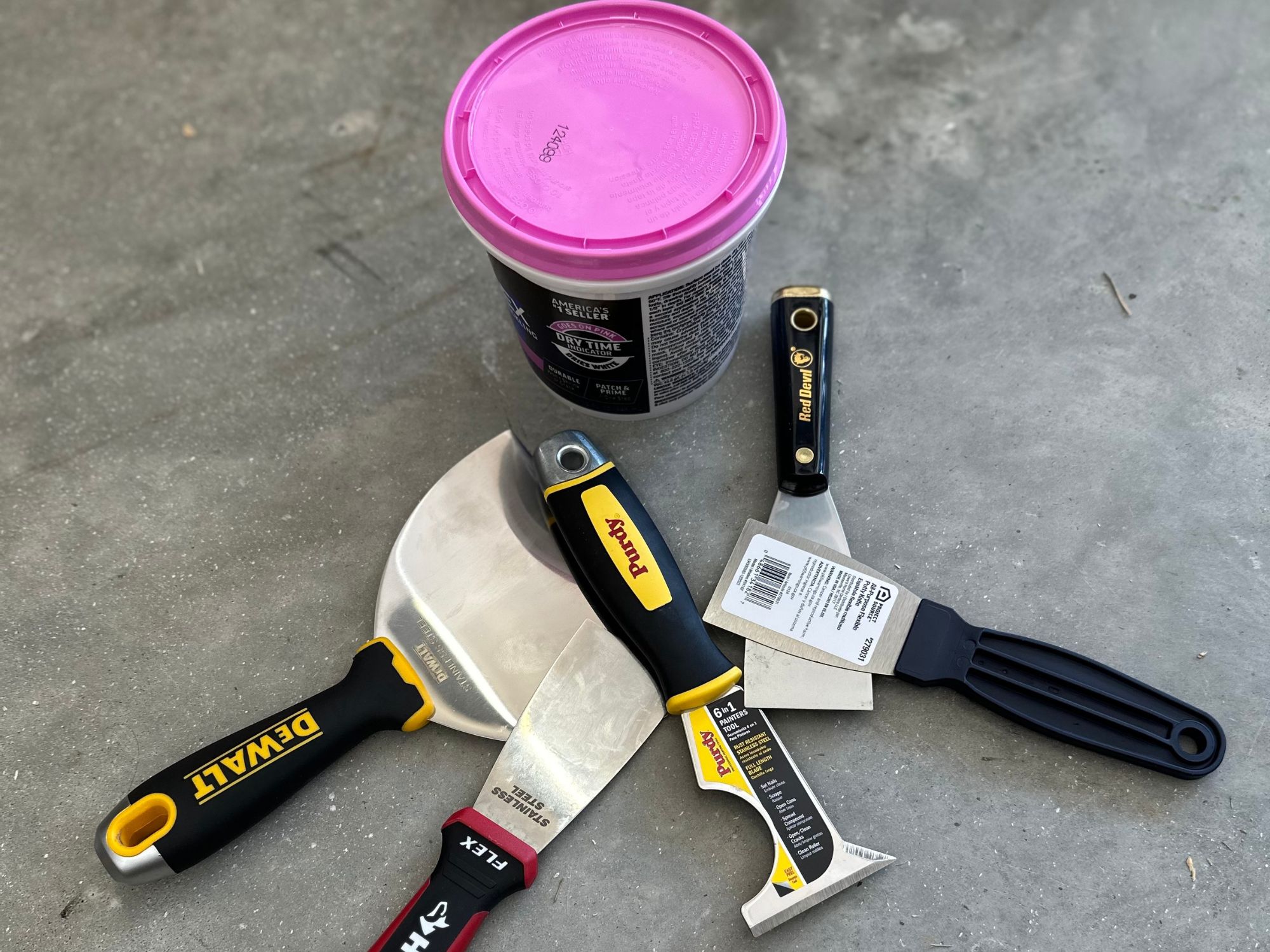
Along with the Husky model, these putty knives also performed well in my testing and come from brands with reputations for manufacturing quality tools.
- Project Source DIY Flex 2-in Steel Putty Knife, available at Lowe’s.
- DeWalt 6-Inch Stainless Steel Putty Knife, available at Amazon or The Home Depot.
- Purdy 14A900210 Surface Prep Painters Tool, available at Amazon.
- Red Devil 4206 2-Inch Flex Putty Knife, available at Amazon.
Jump to Our Top Picks
How We Tested the Best Putty Knives
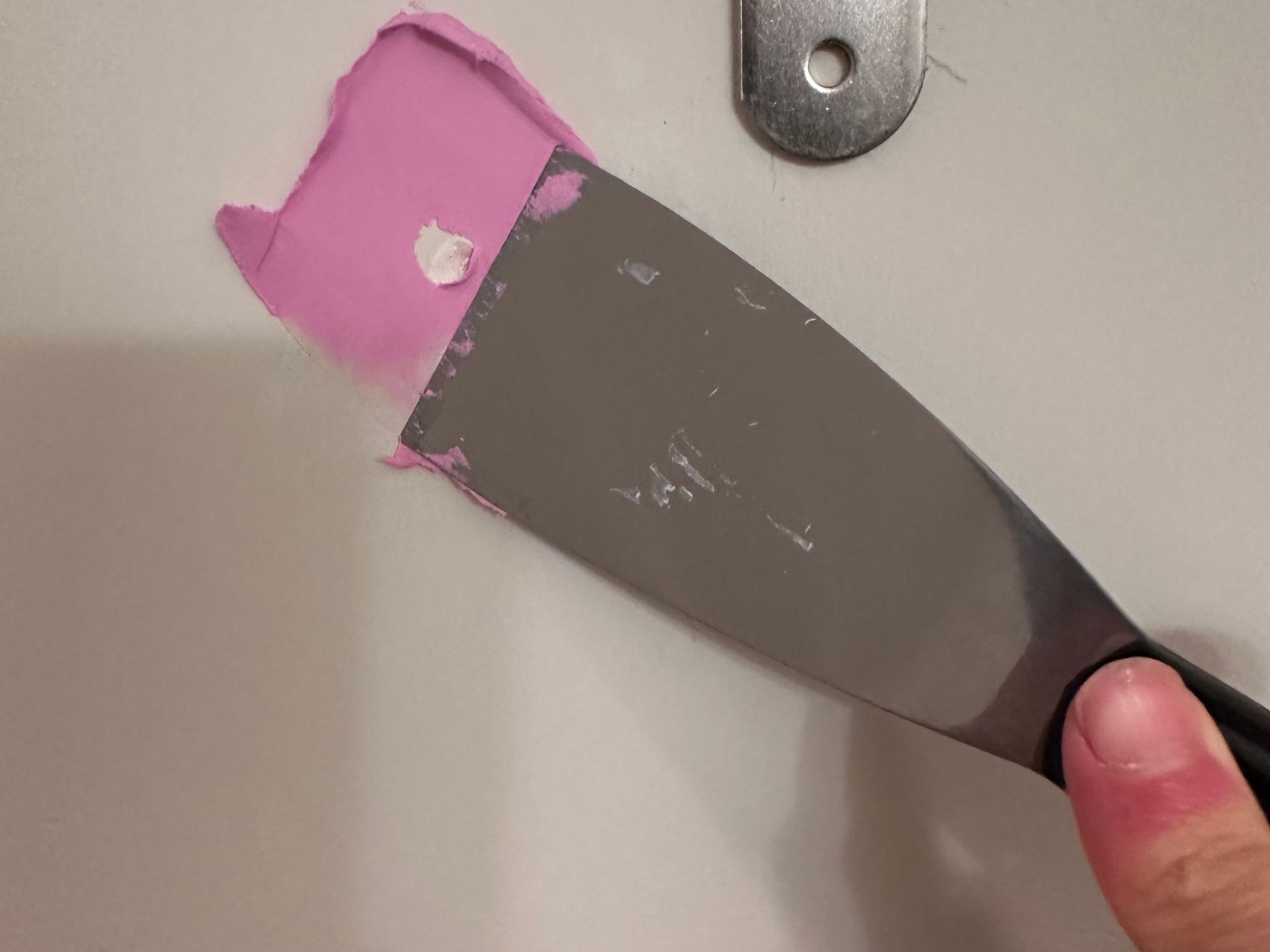
I evaluated the above putty knives by putting them to the test on some of the most common projects that demand a putty knife: spreading spackle and scraping paint. I considered how easy it was to complete each job, noting the flexibility of the knife and the durability of the metal and the edge. I also considered the handle, evaluating its weight, how well it fit in my hand, and how comfortable it was to hold. Last, I noted the overall value of each putty knife by factoring in performance, durability, and price.
What to Consider When Choosing a Putty Knife
The best putty knife is available in two types of materials and a broad range of sizes. Read on to discover which type and size works best for your needs so you can choose the right scraper for any job.
Types of Putty Knives
A putty knife, which is sometimes called a spackle knife, comes in two material types: plastic and stainless steel.
- Plastic putty knives are essentially disposable and intended for spreading spackle. The plastic material simply isn’t durable enough to endure scraping paint or wallpaper. As a result, a plastic putty knife is meant for smaller spackling jobs, such as filling nail holes. It lacks the flexibility to spread larger amounts of spackle evenly.
- Stainless steel putty knives can last for many jobs and are strong enough to double as a scraper. They are constructed of thin, flexible sheet metal ideal for spreading spackle smoothly over a wall or a ceiling yet rigid enough to separate old paint or wallpaper from a wall.
- Painter’s tools are putty knives that can function as many tools. As with standard putty knives, they can scrape paint or apply spackle. Painter’s tools also have a curved side ideal for cleaning paint out of rollers. Some tools also feature built-in can openers, nail pullers, and even a hammer end for pounding paint cans closed.
Blade Size
Spackling knives are available in a variety of blade sizes to suit different jobs. Putty knives with 2-inch or 3-inch blades are ideal for spackling nail holes and other minor damage to drywall prior to painting. This size of knife is also useful for pulling putty out of smaller containers. A wide putty knife with a 6-inch to 8-inch blade is a good choice for embedding compound tape, laying a first coat of mudding on drywall, or repairing larger holes. Large 10-inch blades are suitable for laying finishing coats when mudding drywall to achieve a smooth, professional look.
FAQs
If you’re wondering whether you need a plastic or metal putty knife for a particular job, or even which jobs are appropriate for a putty knife, then read on for more expert insight into these tools.
The best material for a putty knife is stainless steel. Stainless steel flexes well, won’t be corroded by the moisture in putty, and won’t break. While a plastic putty knife is suitable for minor patching jobs, the lack of flexibility makes it more difficult to lay an even coat of spackle drywall mud, and it can’t function as a scraper.
A stiff putty knife is ideal for heavy scraping jobs that involve stripping away old paint or wallpaper, while a flexible putty knife is better suited for spreading and feathering spackle and joint compound.
While it usually isn’t necessary to sharpen a putty knife, you can use a file to ensure the blade is straight with a 90-degree edge.
A putty knife is typically smaller and stiffer, which makes it better suited for working in corners and other tight spots and for scraping old paint or wallpaper. A taping knife is generally wider and more flexible, making it ideal for spreading and feathering joint compound.
Meet the Tester
Tony Carrick is a freelance writer specializing in home improvement, landscaping, technology, home security, and design for such sites and publications as Popular Mechanics, Pro Tools Review, CNN Underscored, and This Old House Magazine.
